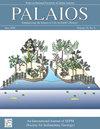BENTHIC FORAMINIFERAL MORPHOGROUPS AND TRACE FOSSILS FROM ALBIAN SHALLOW-MARINE MUDSTONE FACIES OF THE VIKING FORMATION, WESTERN INTERIOR SEAWAY, CANADA
IF 1.5
4区 地球科学
Q2 GEOLOGY
引用次数: 0
Abstract
Abstract: This study assesses the foraminiferal morphogroup concept as a quantitative tool for interpreting environments of deposition in the geological record. This was achieved by first establishing a solid paleoenvironmental framework based on assessment of trace fossils (Zoophycos, Cruziana, and Phycosiphon ichnofacies, and the unnamed brackish-water association), sedimentology, and facies analysis of shallow-marine siliciclastic units of the upper Albian Viking Formation of the Western Interior Seaway, Canada. Foraminiferal morphogroups were integrated into a framework of six well-defined marine mudstone-dominated facies—estuarine, embayment, prodelta, upper offshore, lower offshore, and marine shelf. Seven morphogroups were recognized, quantified, and labeled using alphanumeric codes—A (tubular), B1 (globular), B2 (coiled, flat), B3 (lenticular), C1 (elongate), C2 (quinqueloculine), and D (trochospiral). Tubular forms (A, Bathysiphon) occur rarely in these shallow-marine facies. Globular forms (B1, Lagenammina) are common in estuarine (33%) and embayment (23%) facies, but also occur elsewhere in low numbers (7–14%). Coiled planar forms (B2, Ammodiscus) occur only rarely (1–8%), but have a minor presence in embayment facies (8%). Lenticular forms (B3, Haplophragmoides) are dominant in estuarine facies (43%) and occur commonly in other environments (9–29%) as well. Elongate forms (C1, Ammobaculites, Reophax, Verneuilinoides) dominate all shallow-marine facies (43–80%), except estuarine (10%). Quinqueloculine forms (C2, Miliammina) have a minor presence in prodelta and marine facies (5%) but are generally rare. Trochoid forms (D, Trochammina) occur rarely, but are relatively common in the prodeltaic facies (15%). Albian foraminiferal morphogroups of the Viking Formation are comparable to those of modern-day offshore environments from water depths of 13 to 160 meters. Foraminiferal morphogroups are objective entities independent of taxonomic determinations. Analysis of their form and function is applicable not only in the shallow-marine facies of the Albian Western Interior Seaway, but in similar facies throughout the geologic record.加拿大西部内陆海道维京组浅海浅海泥岩相底栖有孔虫形态群及痕迹化石
摘要:本文对有孔虫形态群概念作为解释地质记录中沉积环境的定量工具进行了评价。这是通过首先建立一个坚实的古环境框架来实现的,该框架是基于对微量化石(Zoophycos、Cruziana和Phycosiphon鱼相,以及未命名的咸淡水组合)的评估、沉积学和对加拿大西部内陆海道上部Albian Viking组浅海硅屑单元的相分析。有孔虫形态群被整合到6个明确的海相泥岩为主的相框架中——河口、河口、前三角洲、上近海、下近海和海陆架。7个形态群被识别、量化,并使用字母数字代码进行标记:a(管状)、B1(球状)、B2(卷曲、扁平)、B3(透镜状)、C1(细长)、C2(半轴状)和D (trochospiral)。管状(A,深虹吸)在这些浅海相中很少出现。球状(B1, Lagenammina)在河口相(33%)和河口相(23%)中很常见,但在其他地方也有少量(7-14%)。盘绕平面型(B2, Ammodiscus)很少出现(1-8%),但在海套相中也有少量存在(8%)。透镜状形态(B3, Haplophragmoides)在河口相中占主导地位(43%),在其他环境中也常见(9-29%)。除河口相(10%)外,所有浅海相中以长形(C1、Ammobaculites、Reophax、Verneuilinoides)为主(43-80%)。在前三角洲和海相中有少量的quinquelocine形式(C2, Miliammina)(5%),但通常很少见。齿状体(D, Trochammina)很少出现,但在原三角洲相中相对常见(15%)。维京组的Albian有孔虫形态群与现代近海环境中水深13至160米的有孔虫形态群相当。有孔虫形态群是独立于分类学决定的客观实体。对其形态和功能的分析不仅适用于阿拉边西部内陆海道的浅海相,而且适用于整个地质记录的类似相。
本文章由计算机程序翻译,如有差异,请以英文原文为准。
求助全文
约1分钟内获得全文
求助全文
来源期刊

Palaios
地学-地质学
CiteScore
2.80
自引率
12.50%
发文量
40
审稿时长
6 months
期刊介绍:
PALAIOS is a monthly journal, founded in 1986, dedicated to emphasizing the impact of life on Earth''s history as recorded in the paleontological and sedimentological records. PALAIOS disseminates information to an international spectrum of geologists and biologists interested in a broad range of topics, including, but not limited to, biogeochemistry, ichnology, paleoclimatology, paleoecology, paleoceanography, sedimentology, stratigraphy, geomicrobiology, paleobiogeochemistry, and astrobiology.
PALAIOS publishes original papers that emphasize using paleontology to answer important geological and biological questions that further our understanding of Earth history. Accordingly, manuscripts whose subject matter and conclusions have broader geologic implications are much more likely to be selected for publication. Given that the purpose of PALAIOS is to generate enthusiasm for paleontology among a broad spectrum of readers, the editors request the following: titles that generate immediate interest; abstracts that emphasize important conclusions; illustrations of professional caliber used in place of words; and lively, yet scholarly, text.
 求助内容:
求助内容: 应助结果提醒方式:
应助结果提醒方式:


